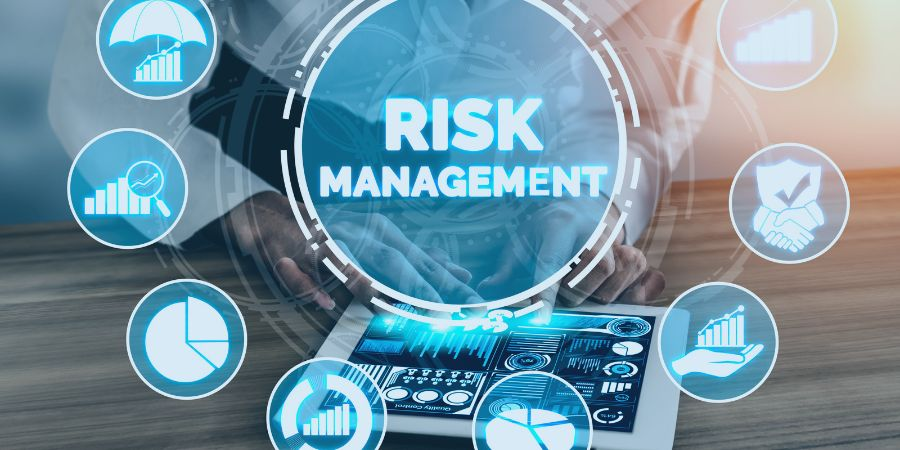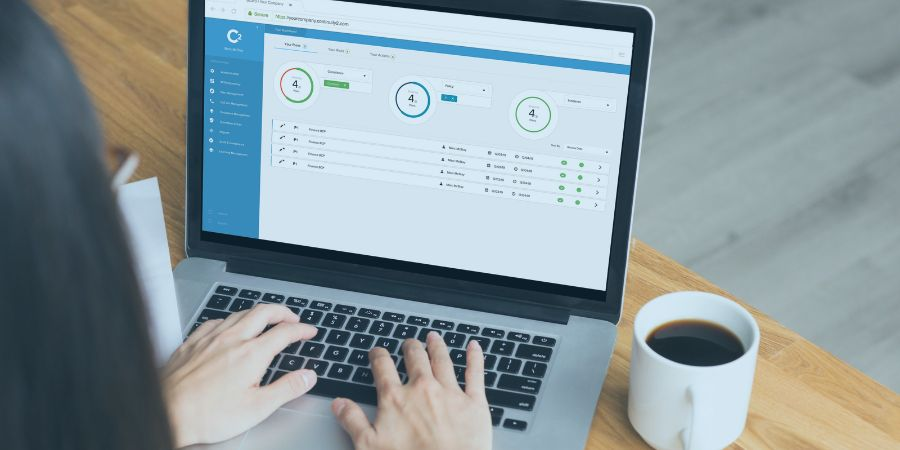What Are The Relationships Between Disaster Recovery, Risk Management and Business Continuity?
Published on March 18, 2019
Last updated on June 25, 2024
Jump to a section
Understanding The Different Concepts
Running a business comes with its set of challenges, and managing risks is one of them. From natural disasters and cyber-attacks to economic downturns and supply chain disruptions, businesses are exposed to a variety of threats that can cause financial losses and reputational damage. Therefore, disaster recovery, risk management and business continuity planning are essential components of any successful business strategy to ensure sustainability.
Let's take a deep dive at the concepts of disaster recovery, risk management and business continuity management and discuss how they can help businesses minimize the impact of potential risks and ensure continuous operations, even during unplanned events.

Business Continuity
Business continuity management ensures that organizations can continue operating their critical business activities during a crisis. It involves developing and implementing strategies and procedures to enable an organization to respond to an unexpected event such as a natural disaster, cyber attack, power outage or another kind of emergency.
The main goal of a business continuity plan is to mitigate the impact of disruptions on an organisation's operations, reputation and bottom line. By having a comprehensive business continuity plan, companies can reduce downtime, maintain customers' trust and loyalty and prevent financial losses.
A business continuity plan should be reviewed and updated regularly to ensure that it remains relevant and effective. The entire organization must be involved, from management to employees and suppliers to ensure that everyone is aware of their roles and responsibilities in the event of an emergency.
Risk Management
Although there has never been an official term defined, Risk Management (RM) is explained by the Economic Times as РІР‚пїЅthe practice of identifying potential risks in advance, analysing them and taking precautionary steps to reduce/curb the risk.РІР‚в„ў
In laymanРІР‚в„ўs terms, risk management is about attempting to prevent business disruptions from happening entirely. In contrast, business continuity focuses on maintaining functionality should a disaster occur by predetermining what minimum levels of staff, systems, resources, etc... are required before operations can continue within an organization.
The first step of risk management is about identifying potential threats which can arise from both internal and external sources. The next step is to assess the potential impact of each risk and prioritize them based on the likelihood of occurrence and the potential severity of impact. Organizations can then develop strategies to mitigate or avoid the risks.
Just like business continuity planning, risk management requires continuous monitoring and evaluation of risks, as well as regular updates to risk management strategies and plans. Everyone in the organization must be involved, from top management to front-line employees, to ensure that risks are identified and managed effectively.
Disaster Recovery (DR)
If business continuity covers how to recover in case of a disruption, what is the purpose of the Disaster Recovery concept? The answer is all about the technology side of things - technical systems, servers and processes.
If BC is around determining minimum requirements to continue operations, DR is about the tangible elements within those minimum requirements.
DR focuses on laying out the critical systems required and identifying how long can pass before an unacceptable level of data is lost due to a disruption, deemed an organization's Recovery Point Objective (RPO), and how quickly an organization must recover its business processes to avoid negative consequences following an incident, the Recovery Time Objective (RTO).
The BC concept is then much more of a broader approach than that of DR – looking at getting an entire business up and running again following an incident, to include not just systems but all of the additional elements which allow a firm to operate including premises, people and external partners/suppliers – so much so that it can be said that disaster recovery forms part of a complete BCMS.

Why Do You Need to Plan For Potential Threats
Two things always come with a risk: potential disruptions and the consequences they bring.
While risk is always possible, it can be challenging to spot, let alone prepare and succeed against them. But if you donРІР‚в„ўt see them coming and havenРІР‚в„ўt planned the appropriate course of action, risk can cause you time, money, and reputation. Similarly, miscalculating and overeating to perceived risks can do more harm than good; it can cause you to panic and have unnecessary reactions.
This is where the importance of the risk analysis tool gets into the picture. It doesnРІР‚в„ўt only pinpoint the risk you could face; it can also help you understand them fully, allowing you to manage and minimize their impact on your business.
Risk analysis tools help you approach risk objectively. It enables you to identify the things you can and cannot control and deal with issues appropriately in a measured and well-thought action. Being prepared for emergencies gives a sense of security and peace of mind both in and outside work.
Subsequently, a risk management plan prepares your business financially. By prioritizing risk management and planning to deal with perceived risks, you improve your organizationРІР‚в„ўs appeal to lenders and protect your companyРІР‚в„ўs interest and resources. And since the business is ready and able to deal with any perceived risks, you can focus on the most important things, such as working towards your goals.
Moreover, risk management gives your company the boost it needs in terms of branding. Letting your stakeholders (employees, customers, business partners, etc.) know that you have it in place tells everybody you are a responsible and resourceful company.
Lastly, risk management can provide you with information and data that may be useful for different purposes in the future. Since risk management is a collaborative effort, the gathered and learned knowledge from developing a risk management plan can be applied to various situations well after the plan's development. This saves the organization from starting from scratch whenever a problem arises.

Key Areas to Focus on When Building a Business Continuity Plan
While there is no one-size-fits-all approach to creating business continuity plans, there are several key areas that organizations should focus on to ensure their plan is efficient.
By understanding these key areas, organizations can develop a comprehensive and effective business continuity plan that can help them navigate unexpected disruptions and ensure the business can stay afloat.
Risk Assessment
Every organization is different; thus, every company face risks unique to them. One thing is sure for every organization, though – everyone needs to identify and conduct a thorough assessment of their perceived risks.
A well-conducted risk assessment helps businesses to:
- Pinpoint potential threats and hazards to their functions.
- Evaluate the likelihood and impact of those potential disruptive events.
- Develop strategies and plans to mitigate or manage them in order to reduce downtime.
- Prioritize resources and investments based on the level of risk.
- Continuously monitor and review risks to ensure that the business remains prepared and resilient whatever happens.
Identify the key processes and functions of your business activities
The first step to identifying the risk is pinpointing the critical functions, assets and processes that must be protected to ensure sustainability. This can be multiple things, such as your supply chain, ability to always meet legal standards, internet connection, communication channels, etc ...
Identify the threats
After identifying the critical processes of your operations, you can now pinpoint the threads to them. Again, this can be any kind of emergency, from a supply chain disruption, loss of key staff (which can affect your business operation), technical failure (caused by a disruption in your internet connection), change of government policy, etc.
Also, determine which events can adversely impact your business operations and prevent your teams from achieving their objectives.
Have a probability/risk impact chart
There is a good chance you will end up with a long list of potential threats. Realistically speaking, having a contingency plan for everything is nearly impossible. This is where you need to prioritize. And to list down all the things that you need to prioritize, you need to make a chart.
A risk impact chart will help you analyze the possible effect of each perceived risk and its likelihood of happening. From here, you can pinpoint which risks require your attention, resources, and planning for risk mitigation.
You should prioritize those risks that impact your business process and the survival of your organization, such as maintaining the necessary cash flow, market share, etc. These must be at the top of your priority list.
Create a contingency plan
Once you have identified the risks and their undesirable consequences, you can start making your contingency plan.
It should define the scope of the possible problem, when to put it into action, and what you need to take to accomplish the tasks.
Different risks will have various contingency plans. Thus, break them down to reveal the likelihood that they may occur. From here, you can identify the preventative measures you can take to mitigate risk or even prevent it from happening in the first place.
Develop a disaster recovery plan
Develop a detailed disaster recovery plan that outlines the steps you must take to restore critical IT systems, data and applications to a functioning state as quickly as possible in times of disruption.
It includes backups, redundant systems and other measures designed to ensure the company can recover from a disaster and resume normal operations as soon as possible.

Treat and monitor the risk
Once you have identified the worst-case scenario and have laid out the plan to mitigate them, it is time to treat the risk.
While it is seemingly impossible to anticipate everything, your previous steps should set you up for success. Starting with the highest priority risk, task your team to mitigate or solve the risk before it happens. This way, you can solve problems before they arise – risks will no longer threaten your business.
Treating or mitigating risks efficiently means tackling them without compromising your organisation's resources or derailing the projects that your teams are working on in the present.
Keep everyone on the same page
There are cases where you cannot solve problems that aren’t there. The best way to anticipate them is to monitor them. This is where clear communication among your team and stakeholders gets crucial – everyone should be on the same page and should know their roles.
Another way to monitor risks is to check in with your risk managers individually and regularly. Make sure there are no red flags in any project.
Update your risk logs regularly
Managing risks is an important aspect of your continuity plans. One way to do so is by maintaining a risk register - a document that identifies potential threats and outlines strategies for addressing them. However, it's not enough to create a risk register and leave it untouched throughout the project.
To effectively manage risks, it's crucial to update the risk register. This means regularly reviewing the document, assessing the likelihood and impact of identified risks, and adding new risks as they emerge. By doing this, you can ensure that your risk register remains relevant and accurate.
Everyone in the business must have access to the latest information on risks and how they are being managed.
Managing Risk with Continuity Planning Software
Business continuity management software (BCMS) is an application used to develop, manage, and implement the organizationРІР‚в„ўs continuity plan to keep the operations running amidst a crisis or any unexpected disruption in the business.
This software usually falls into one of two categories: the first is the app that helps businesses analyze risks in different scenarios and then develop a business continuity plan to minimize its impact. An excellent example of this app provides real cost estimates and other impacts caused by outages in a particular business function. This is commonly referred to as a “business continuity management application.”
The second application that businesses use for BCP management is during a disaster. The most common example of this is a backup and recovery tool. They are often referred to as “business continuity solutions.” These two categories are sometimes used together as part of a comprehensive and integrated solution.
Often, these technologies are part of the organizationРІР‚в„ўs overall strategy and toolkit to ensure continuous operation and resiliency against unwanted risks.

Summary
So, what's the takeaway here?
The most comprehensive solution an organisation can adopt to protect itself best and minimise loss and negative impacts in any business disruption is to undertake and integrate the three concepts we discussed above: disaster recovery, risk management and business continuity management. They will work in a complementary fashion to one another.
Of course, no matter how much planning an organisation carries out, there is still no way to guarantee a business disruption will not take place, so albeit risk management is an essential practice for any organisation, it cannot be successful as a stand-alone practice. If a company wishes to prepare itself best for such incidents, it would also require a Business Continuity Management System (BCMS).
C2's Meridian allows you to create, store, manage and distribute business continuity plans through smart automation and data collection. Our BCMS features key modules such as Business Impact Analysis, Risk Management, Exercise and Training and more, to make your job easier. Get in touch today to see it in action.
Written by Donna Maclellan
Lead Risk and Resilience Analyst at Continuity2
With a first-class honours degree in Risk Management from Glasgow Caledonian University, Donna has adopted a proactive approach to problem-solving to help safeguard clients' best interests for over 5 years. From identifying potential risks to implementing appropriate management measures, Donna ensures clients can recover and thrive in the face of challenges.


Written by Donna Maclellan
Lead Risk and Resilience Analyst at Continuity2
With a first-class honours degree in Risk Management from Glasgow Caledonian University, Donna has adopted a proactive approach to problem-solving to help safeguard clients' best interests for over 5 years. From identifying potential risks to implementing appropriate management measures, Donna ensures clients can recover and thrive in the face of challenges.